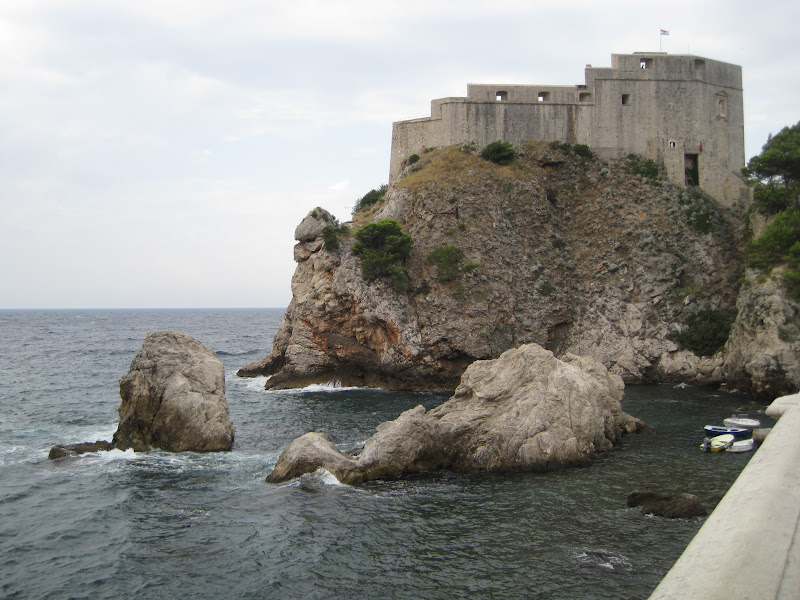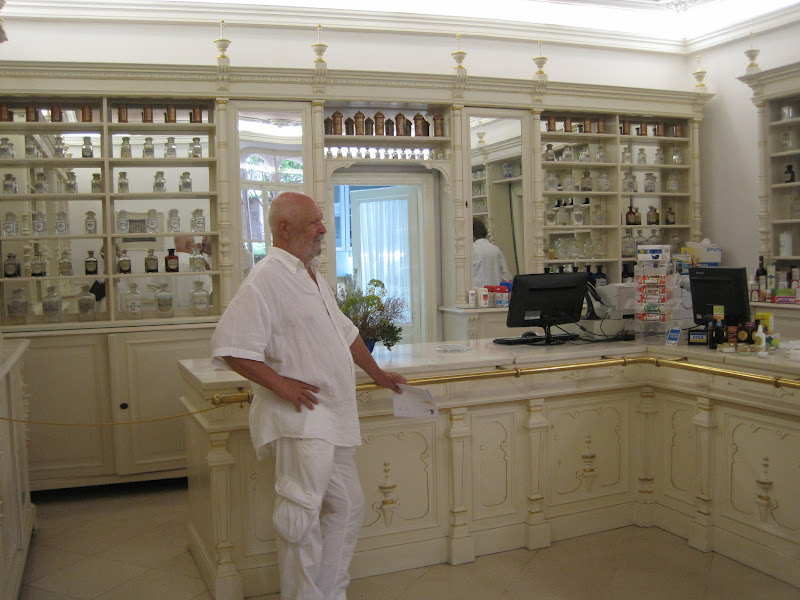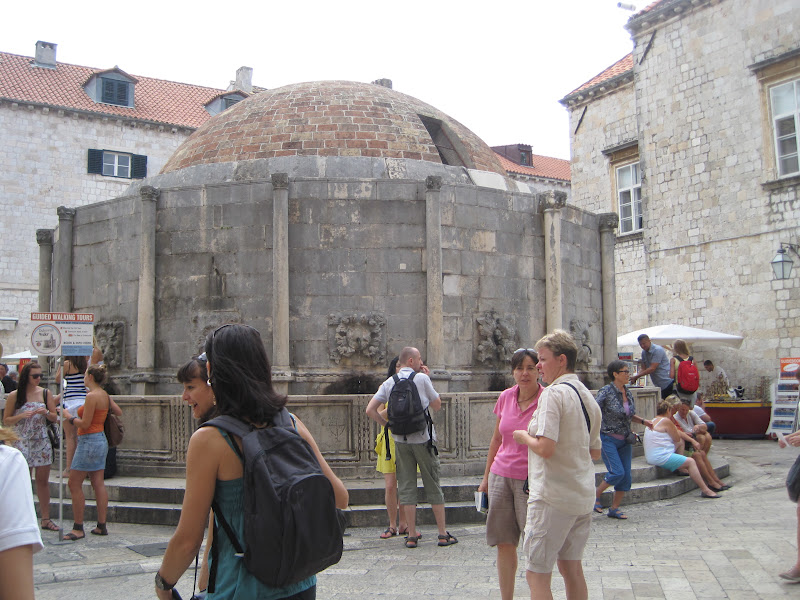BY JANET STEINBERG
“If you want to see heaven on
Earth, come to Dubrovnik”. George Bernard Shaw
Earth, come to Dubrovnik”. George Bernard Shaw
Henceforth, when I hear the word ‘Dalmatian’, I won’t
think of that regal white dog with black spots. Instead, I will think of that exquisite Dalmatian Coast which I recently had the pleasure
of sailing along on two different Crystal Serenity cruises.
think of that regal white dog with black spots. Instead, I will think of that exquisite Dalmatian Coast which I recently had the pleasure
of sailing along on two different Crystal Serenity cruises.
The jewel in the crown of this
impressive Croatian coast, with its 1185 islands, islets and reefs, is Dubrovnik, affectionately dubbed “The Pearl of the Adriatic”.
impressive Croatian coast, with its 1185 islands, islets and reefs, is Dubrovnik, affectionately dubbed “The Pearl of the Adriatic”.
Dubrovnik is a city where every stone is steeped in
history. Yet, it is a pulsating city that is alive in the
present. In this ancient walled city,
perfumed by sea air, there is a confluence of the past and the present.
history. Yet, it is a pulsating city that is alive in the
present. In this ancient walled city,
perfumed by sea air, there is a confluence of the past and the present.
 |
| THE ANCIENT WALLS OF THE OLD CITY HUG THE CROATIAN COAST |
Dubrovnik is a unique blend of European flavors, a city of
fascinating diversity, rich in history and culture. It is a museum in and of itself.
One of the most romantic cities in the world, Dubrovnik
is what Europe used to be.
The city’s
fortified Old City
is framed by its ancient walls, soaring limestone cliffs, and a dazzling Adriatic Sea. The thick, medieval, stone walls and the
system of turrets and towers that encircle the city once protected the
vulnerable city from would-be conquerors.
Moats ran around the outside section of the city walls. The medieval town center, a UNESCO World
Heritage site, is known locally as Stari Grad.
fortified Old City
is framed by its ancient walls, soaring limestone cliffs, and a dazzling Adriatic Sea. The thick, medieval, stone walls and the
system of turrets and towers that encircle the city once protected the
vulnerable city from would-be conquerors.
Moats ran around the outside section of the city walls. The medieval town center, a UNESCO World
Heritage site, is known locally as Stari Grad.
Within those walls the streets are paved
in marble and lined with historic palaces, fountains, museums, churches and a
synagogue that is the world’s oldest Sephardic synagogue still in use today and
the second oldest synagogue in Europe.
in marble and lined with historic palaces, fountains, museums, churches and a
synagogue that is the world’s oldest Sephardic synagogue still in use today and
the second oldest synagogue in Europe.
 |
| WITHIN THE ANCIENT WALLS, THE STREETS ARE PAVED IN MARBLE |
The Baroque-style Old Synagogue of
Dubrovnik is located on the tiny Ulica
Zudioska (“Jewish Street”).
Established in the 14h century, this treasure managed to survive a
devastating earthquake, two World Wars, a Communist regime, and the 1991
Homeland War with Yugoslavia. The
Synagogue now functions mainly as a museum showcasing ancient artifacts and
ritual items.
Dubrovnik is located on the tiny Ulica
Zudioska (“Jewish Street”).
Established in the 14h century, this treasure managed to survive a
devastating earthquake, two World Wars, a Communist regime, and the 1991
Homeland War with Yugoslavia. The
Synagogue now functions mainly as a museum showcasing ancient artifacts and
ritual items.
The Franciscan monastery, one of the many finely
built monasteries in the Old City, is situated at the very beginning of Placa, to
the left of the Pile (pronounced Pea-lay) Gate entrance to the Old City. Its Cloister is one of the most valuable late
Romanesque creations on the Croatian shores of the Adriatic.
built monasteries in the Old City, is situated at the very beginning of Placa, to
the left of the Pile (pronounced Pea-lay) Gate entrance to the Old City. Its Cloister is one of the most valuable late
Romanesque creations on the Croatian shores of the Adriatic.
The third oldest, continuously functioning pharmacy
in the world still operates within the Franciscan Monastery. However, the pharmacy’s original fixtures are
now protected in the museum within the Monastery. The museum also spotlights a missile (Udar
Granate) shot into the concrete wall on December 6, 1991, during the Homeland
War. The Franciscan monastery’s library possesses 30,000 volumes.
in the world still operates within the Franciscan Monastery. However, the pharmacy’s original fixtures are
now protected in the museum within the Monastery. The museum also spotlights a missile (Udar
Granate) shot into the concrete wall on December 6, 1991, during the Homeland
War. The Franciscan monastery’s library possesses 30,000 volumes.
 |
| THE THIRD OLDEST, CONTINUOUSLY FUNCTIONING PHARMACY IN THE WORLD |
Orlando’s Column, located in the center of town, is the
symbol of the freedom of Dubrovnik. It is also the psychological center of the city.
Orlando’s Column is named in honor of the knight Roland (“Orlando” is the
Italian name for the French name “Roland”). It was erected to celebrate
the city’s defeat of the Venetians in 972. It was here that public notices were
posted, pubic rallies were held, and public punishments were performed.
The Morning Market in the Old City
is a great place to get a glimpse of the real people who live in what has become
a major tourist destination. The warm smiles and the cheery broken English
welcomes of the vendors are sincere. The marketplace is the place to buy
souvenirs, lavender products, the work of local artisans, and what the fruit
vendors tout as “the best figs in Croatia”.
is a great place to get a glimpse of the real people who live in what has become
a major tourist destination. The warm smiles and the cheery broken English
welcomes of the vendors are sincere. The marketplace is the place to buy
souvenirs, lavender products, the work of local artisans, and what the fruit
vendors tout as “the best figs in Croatia”.
 |
| THE MORNING MARKET |
If you are into fine jewelry, make a stop at
Clara Stones Jewellery Store, located at Naljeskoviceva 8. Clara
Stones creative team comes up with eclectic combinations of corals, pearls, and
gemstones. The unique handcrafted designs range in price from $35
to $20,000
Clara Stones Jewellery Store, located at Naljeskoviceva 8. Clara
Stones creative team comes up with eclectic combinations of corals, pearls, and
gemstones. The unique handcrafted designs range in price from $35
to $20,000
Directly across from Clara Stones is Dolce
Vita, the place that my guide recommended for the best ice cream in
Dubrovnik. It doesn’t have the fancy display of the ice cream
shops on the main street, but it reputed to be better and less
expensive.
Vita, the place that my guide recommended for the best ice cream in
Dubrovnik. It doesn’t have the fancy display of the ice cream
shops on the main street, but it reputed to be better and less
expensive.
The Onofrio fountains
were named after the Neapolitan engineer Onofrio who designed the fountains and
the aqueduct that supplied Dubrovnik with its water in 1444. The two Fountains
of Onofrio decorate the beginning and the end of the pedestrian main street
known as the Stradun.
were named after the Neapolitan engineer Onofrio who designed the fountains and
the aqueduct that supplied Dubrovnik with its water in 1444. The two Fountains
of Onofrio decorate the beginning and the end of the pedestrian main street
known as the Stradun.
The 16-sided Big
Onofrio fountain ejects water out of the mouths of its stone
masks. Little Onofrio Fountain is part of the same water project
as its larger cousin to the west but was built to supply water to the market
place on Luza Square. Dubrovnik was one of few European cities that had safe
spring water
Onofrio fountain ejects water out of the mouths of its stone
masks. Little Onofrio Fountain is part of the same water project
as its larger cousin to the west but was built to supply water to the market
place on Luza Square. Dubrovnik was one of few European cities that had safe
spring water
 |
| THE 16-SIDED BIG ONOFRIO FOUNTAIN |
For an overall view of the terracotta red roofed Old City of
Dubrovnik, and for a nominal price, you can walk around the top of the city’s
ancient walls. While climbing the narrow steps to the top of the
wall, you will continuously discover new views.
Dubrovnik, and for a nominal price, you can walk around the top of the city’s
ancient walls. While climbing the narrow steps to the top of the
wall, you will continuously discover new views.
Adjacent to the Pile Gate is the Dubravka Restaurant, a huge
reasonably priced restaurant with magnificent terrace views of fortresses and
the Adriatic Sea. Located on the Brsalje Square at the Pile Gate
entrance to the Old City, it offers a great selection of fresh seafood and
Croatian specialties.
reasonably priced restaurant with magnificent terrace views of fortresses and
the Adriatic Sea. Located on the Brsalje Square at the Pile Gate
entrance to the Old City, it offers a great selection of fresh seafood and
Croatian specialties.
Restaurant Mimoza, just a short walk from the
Old Town, (across from the Hilton Imperial Hotel) was established in
1953. It is said to be one of the best restaurants in the
Dubrovnik. The restaurant serves indigenous traditional Mediterranean
delicacies including fish, lamb, and veal. Start with their fresh
seafood sampler.
Old Town, (across from the Hilton Imperial Hotel) was established in
1953. It is said to be one of the best restaurants in the
Dubrovnik. The restaurant serves indigenous traditional Mediterranean
delicacies including fish, lamb, and veal. Start with their fresh
seafood sampler.
As Liza Minnelli’s sang in the song “Ring Them Bells”… “You must try
Dubrovnik before you go home…”
Dubrovnik before you go home…”
 |
| CRYSTAL SERENITY DEPARTS DUBROVNIK |
JANET
STEINBERG is the winner of 38 national Travel Writer Awards and an International
Travel Consultant with The Travel Authority in Mariemont,
Ohio.
STEINBERG is the winner of 38 national Travel Writer Awards and an International
Travel Consultant with The Travel Authority in Mariemont,
Ohio.
